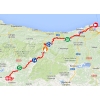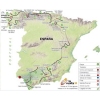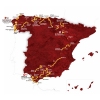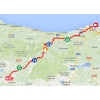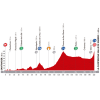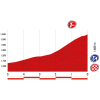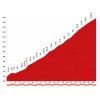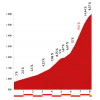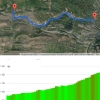The stage leaves Santander, a historical town on the northern coast of Spain. Riders head southeast in what seems to be a relatively easy opening. The first serious climb is Collada de la Hoz (category 2), known from the 2012 edition – when Alberto Contador attacked and laid the foundation for his GC win that year.
Collada de la Hoz is crested at 122 kilometres from the finish line. Drivers drop down and then the road gradually bends upward again, aiming for Puerto de San Glorio (category 1). The climb is long and gradual. At no point it gets really steep, the maximum gradient is 11.7%. It’s the sheer length, over 20 kilometres, making the Puerto de San Glorio a real pain in the ass.
Atop of Puerto de San Glorio it’s time for a break. For the next 70 kilometres riders don’t face any major obstacles. It’s only with 10 kilometres to go the next hurdle awaits them – and what a hurdle it is: La Camperona, debuting in La Vuelta.
The start of the ascent is actually quite comforting. Okay, after the village of Olleros de Sabero the road gets somewhat steeper, with gradients of up to 10%. But this is only the beginning. The party really starts when the riders pass Sotillos de Sabero. The final 3 kilometres are inhuman, with maximum gradients of 19.5%.
Whoever it is with nefarious plans, today is a perfect day for torturing your opponents.
The stage starts at 12:15 (CET) and the finish is expected around 17:40.
Vuelta 2014 stage 14: Images and more
+ Click for more images (10)
Related articles The Route - Vuelta 2014 Riders and teams - Vuelta 2014 Withdrawals - Vuelta 2014 Route and stages - Vuelta 2014 Favourites - Vuelta 2014 More articles Tour of the Alps 2025: Double win Storer in 2nd stage
Tour of the Alps 2025 Route stage 2: Mezzolombardo - Sterzing
Tour of the Alps 2025 Route stage 3: Sterzing - Innechen
Tour of the Alps 2025: Riders
Tour of the Alps 2025 Route stage 4: Sillian – Obertilliach
Tour of the Alps 2025 Route stage 5: Lienz – Lienz
La Flèche Wallonne 2025: The Route
La Flèche Wallonne 2025: Riders
La Flèche Wallonne 2025: Favourites
La Flèche Wallonne Femmes 2025: The Route
La Flèche Wallonne Femmes 2025: Riders
Liège-Bastogne-Liège 2025: The Route
Liège-Bastogne-Liège 2025: Riders
Cycling Calendar 2025
Giro 2025: The Route
Giro 2025: Riders
Giro 2025: GC Favourites
Giro 2025 Route stage 1: Durazzo - Tirana
Giro 2025 Route stage 2: Tirana - Tirana
Giro 2025 Route stage 3: Valona – Valona
Giro 2025 Route stage 4: Alberobello – Lecce
Giro 2025 Route stage 5: Ceglie Messapica - Matera
Giro 2025 Route stage 6: Potenza - Naples
Giro 2025 Route stage 20: Verrès – Sestrière
Tour de France 2025: The Route
Tour de France 2025 Route stage 1: Lille - Lille
Tour de France 2025 Route stage 2: Lauwin-Planque - Boulogne-sur-Mer
Tour de France 2025 Route stage 3: Valenciennes - Dunkirk
Tour de France 2025 Route stage 16: Montpellier - Mont Ventoux
Tour de France 2025 Route stage 18: Vif - Col de la Loze
